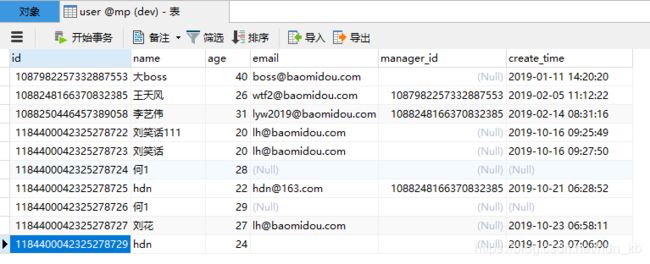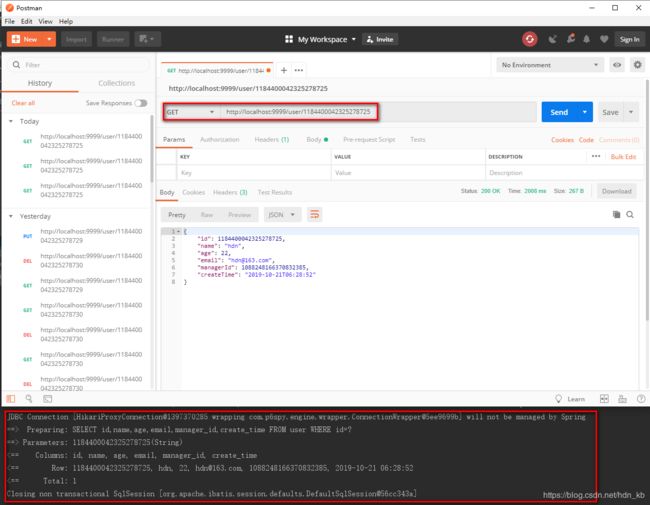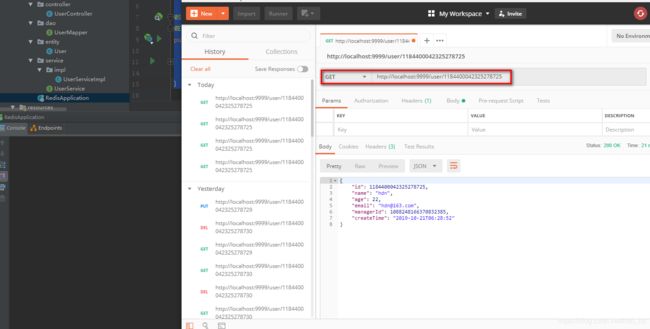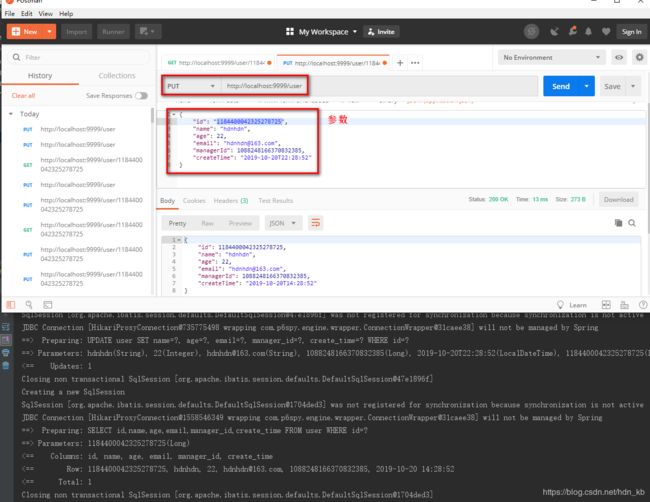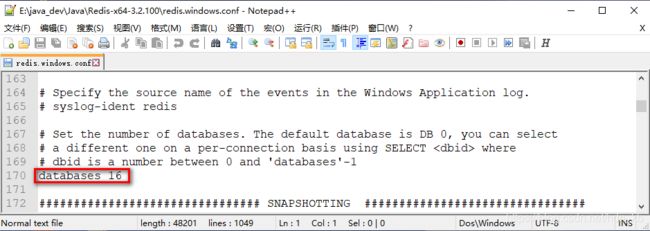以Redis作为缓存技术,使用SpringBoot、MyBatisPlus来演示@Cacheable、@CachePut、@CacheEvit注解
一、知识点
1、redis是什么?
key-value的nosql数据库,先存到内存中,会根据一定的策略持久化到磁盘。
2、主要作用有哪些?
主要用来做缓存数据库和web集群时当做中央缓存存放session。
3、@Cacheable、@CachePut、@CacheEvit、@Caching注解
| 注解 | 解释 |
|---|---|
| @Cacheable | 在方法执行前Spring先查看缓存中是否有数据,如果有数据,则直接返回缓存数据;若没有数据,调用方法并将方法返回值放进缓存 |
| @CachePut | 无论怎样,都会将方法的缓存值放到缓存中,查询数据库的方法总会被调用 |
| @CacheEvit | 将一条或多条数据从缓存中删除 |
| @Caching | 可以通过@Caching注解组合多个注解策略在一个方法上 |
4、注解相关属性
cacheNames/value:指定缓存组件的名称
key:缓存数据使用的key,默认是使用方法参数的值
condition:指定符合条件的情况下缓存
unless:否定缓存,当unless指定的条件为true的时候不进行缓存
5、Spring Boot中配置缓存
spring.cache.type= //配置要使用的缓存
spring.cache.cache-name= //程序启动时创建缓存的名称
二、使用工具
1、mysql数据库
2、安装redis
3、安装redis客户端工具:RedisDesktopManager
三、准备工作
创建Spring Boot工程
在Spring中使用缓存技术的关键是配置CacheManager,而Spring Boot中自动配置了多个CacheManager的实现。
四、编写程序
1、引用依赖
org.springframework.boot spring-boot-starter-web org.springframework.boot spring-boot-starter org.springframework.boot spring-boot-starter-test test mysql mysql-connector-java com.baomidou mybatis-plus-boot-starter 3.3.0 org.projectlombok lombok true p6spy p6spy 3.8.2 org.springframework.boot spring-boot-starter-data-redis 2.2.2.RELEASE
2、配置application.yml文件
server: port: 9999 spring: # 配置数据库信息 datasource: driver-class-name: com.p6spy.engine.spy.P6SpyDriver url: jdbc:p6spy:mysql://localhost:3306/mp?useUnicode=true&characterEncoding=utf-8&serverTimezone=UTC username: root password: 123456 # 配置redis redis: database: 15 host: 127.0.0.1 port: 6379 # 配置使用的缓存:redis cache: type: redis mybatis-plus: configuration: # 这个配置会将执行的sql打印出来,在开发或测试的时候可以用 log-impl: org.apache.ibatis.logging.stdout.StdOutImpl
3、编写dao层
package com.test.redis.dao;
import com.baomidou.mybatisplus.core.mapper.BaseMapper;
import com.test.redis.entity.User;
import org.apache.ibatis.annotations.Mapper;
@Mapper
public interface UserMapper extends BaseMapper{
}
4、编写service
package com.test.redis.service;
import com.baomidou.mybatisplus.extension.service.IService;
import com.test.redis.entity.User;
public interface UserService extends IService {
User updateUser(User user);
User getUser(String userId);
int deleteUser(String userId);
}
实现类:
package com.test.redis.service.impl;
import com.baomidou.mybatisplus.extension.service.impl.ServiceImpl;
import com.test.redis.dao.UserMapper;
import com.test.redis.entity.User;
import com.test.redis.service.UserService;
import org.springframework.cache.annotation.CacheEvict;
import org.springframework.cache.annotation.CachePut;
import org.springframework.cache.annotation.Cacheable;
import org.springframework.stereotype.Service;
@Service
public class UserServiceImpl extends ServiceImpl implements UserService {
@Override
@CachePut(cacheNames = "user", key = "#user.id")
public User updateUser(User user) {
baseMapper.updateById(user);
return baseMapper.selectById(user.getId());
}
@Override
@Cacheable(cacheNames = "user", key = "#id",unless="#result == null")
public User getUser(String id) {
return baseMapper.selectById(id);
}
@Override
@CacheEvict(cacheNames = "user",key = "#id")
public int deleteUser(String id) {
return baseMapper.deleteById(id);
}
}
5、编写controller
package com.test.redis.controller;
import com.test.redis.entity.User;
import com.test.redis.service.UserService;
import org.springframework.beans.factory.annotation.Autowired;
import org.springframework.web.bind.annotation.*;
@RestController
@RequestMapping("/user")
public class UserController {
@Autowired
UserService userService;
@PutMapping
public User updateUser(@RequestBody User user) {
return userService.updateUser(user);
}
@GetMapping(value = "/{id}")
public User getUser(@PathVariable String id) {
User user = userService.getUser(id);
return user;
}
@DeleteMapping(value = "/{id}")
public String deleteUser(@PathVariable String id) {
int i = userService.deleteUser(id);
if(i==1){
return "删除成功";
}
return "删除失败";
}
}
6、在启动类上使用@EnableCaching来开启缓存
package com.test.redis;
import org.springframework.boot.SpringApplication;
import org.springframework.boot.autoconfigure.SpringBootApplication;
import org.springframework.cache.annotation.EnableCaching;
@SpringBootApplication
@EnableCaching
public class RedisApplication {
public static void main(String[] args) {
SpringApplication.run(RedisApplication.class, args);
}
}
五、使用postman进行测试
数据表中的数据:
1、先来从数据库查询一条数据,缓存到redis数据库中(@Cacheable注解 )
第一次查询之后,经过查询mysql数据库查询出来之后缓存到redis数据库中
之后再查询该数据,不经过查询数据库的方法,就直接从redis数据库中返回,如下图可看到控制台没有输出sql语句:
结论:使用@Cacheable注解,第一次查询会经过mysql数据库进行查询,得到结果缓存到redis中。如果redis中已经存在要查询的数据,则就会从redis中取,而不经过mysql数据库。
2、修改一条数据,并更新缓存(@CachePut)
结论:使用@CachePut注解来更新缓存中的数据,每次都会执行操作数据库的方法,将数据库的数据更新之后,再将新的数据更新到缓存中。
此时,再次查询刚刚更新的数据,可看到控制台中没有输出,这次是在缓存中拿到了最新的数据,如下图:
3、删除一条数据,并从缓存中将此数据删除(@CacheEvit)
执行之后,可查看redis中已经将该缓存的数据删除。
六、扩展知识
6.1、Redis默认支持16个数据库可以通过调整Redis的配置文件redis/redis.windows.conf中的databases来修改这一个值,设置完毕后重启Redis便完成配置。
6.2、在实际项目中可以通过配置文件来指定Redis使用的数据库:
6.3、Redis不支持自定义数据库的名字,所以每个数据库都以编号命名。这样,就需要开发者记录存储的数据与数据库的对应关系。
6.4、Redis不支持为每个数据库设置不同的访问密码,所以一个客户端要么可以访问全部的数据库,要么全部数据库都没有权限访问。
6.5、清空Redis实例中所有数据库中数据的命令:FLUSHALL
6.6、对于Redis来说,一个Redis实例不适宜存储不同应用程序的数据。一个Redis实例中不同的数据库可用于存放不同环境的数据;不同应用应该使用不同的Redis实例存储数据。
6.7、Redis集群下只有db0,不支持多db。
